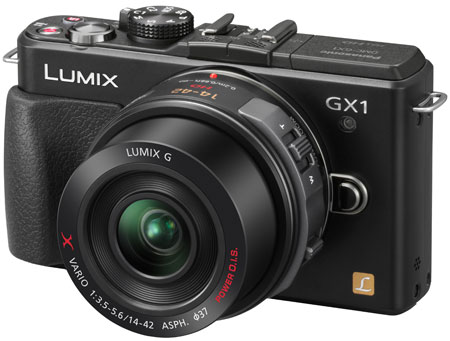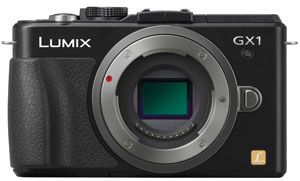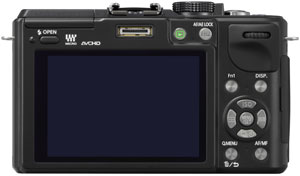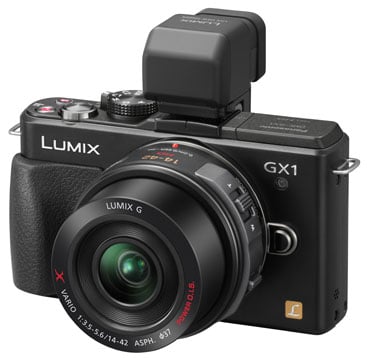Panasonic Lumix DMC-GX1
-
-
Written by Gordon Laing
Verdict
|
Panasonic’s Lumix GX1 is a highly satisfying compact system camera for enthusiasts, especially when equipped with the company’s 14-42mm power zoom lens. It’s small but well-built and comfortable to hold, and feels responsive too with snappy AF and minimal shutter lag. There’s stacks of manual control and customisation if you want it, backed-up by a confident auto mode when you don’t. It also features one of the best touch-screen control systems around, along with plenty of physical dials and buttons if you prefer. The image quality is up there with the best of its peer group and the movie mode delivers very good footage with a decent stab at continuous autofocusing. In short, there’s a lot to like about the GX1. The GX1 is also a perfect example of a company listening to its customers, if arguably later than hoped. Enthusiasts loved the original Lumix GF1 and lamented the steady dumbing-down of the GF range. Across forums you’d hear a common theme: “if only they’d stop taking useful stuff out of the GF series and produce a small CSC with enthusiasts in mind”. Well, that’s essentially what you get with the GX1: the popular GF1 body, beefed-up and equipped with the latest technologies including the respectable 16 Megapixel sensor of the G3.
The sensor is a good place to start discussing the GX1’s performance in more detail. When I tested the earlier Lumix G3, I was very impressed with the image quality of Panasonic’s then new 16 Megapixel MOS sensor: it finally allowed Micro Four Thirds to deliver resolution and noise levels similar to those from the best APS-C DSLRs. The GX1 essentially inherits those capabilities in a smaller form factor and with the right settings can deliver great-looking images. I say ‘right settings’ though because left to its own devices the GX1 can apply a little more processing than I personally like. Sure it’ll eliminate most visible speckles, but with the default settings – and especially in iA mode – images viewed at 100% can lack the ultimate crispness I know this camera’s capable of. If you prefer a smoother look, then you’ll love the default output from the GX1, but if, like me, you favour a crisper look even if it means a smattering of noise textures, then I’d recommend turning the in-camera noise reduction right down. Better still, shoot in RAW and apply the processing style you prefer. In short it is possible to achieve crisp details with the GX1 when viewed at 100%, but you will need to tweak the default settings. The movie quality is also very good, although it’s a shame there’s no manual control over exposure nor any 1080/50p/60p options. On the upside, the GX1 will have a decent stab at continuously autofocusing during filming and does a fair job at tracking action. The touch-screen AF also works really well while filming, allowing you to tap the subject you’d like the camera to refocus on – so much easier than manually pulling-focus on a DSLR, although as a contrast-based system, there is inevitably a little visible searching to confirm focus, something the phase-change AF systems of the Sony SLT and Nikon 1 models can minimise or even eliminate under good light.
One of the highlights of the movie mode though is its ability to record very long clips, at least for models unconstrained by European tax regulations. Frustratingly those GX1s destined for Europe will be limited to 29:59 clips, but others will enjoy clips lasting just over two hours with a fully-charged battery and empty 16GB card. Indeed I used the GX1 to record entire school events and found the long uninterrupted recordings coupled with the tap refocusing made for a killer combination. This is a key advantage non-European GX1s have over rival CSCs and DSLRs. The earlier G3 had one of the fastest AF systems I’d used, which the GX1 manages to fractionally improve upon. Set to Single AF, it feels very quick and confident even with the standard kit lenses. The new AFF mode also works well, allowing the camera to adjust the focus while the shutter release is half-pressed should a subject move a little – great for portraits of fidgety subjects. Like the G3 before it, the GX1 also does a fair job of tracking action, although as mentioned above, it can’t compete with the speed and accuracy of a phase change AF system for subjects in motion. So if you want continuous phase-change AF with live view, you’ll need to go for a Sony SLT or Nikon 1 camera. This extends onto the continuous shooting performance which while fractionally quicker than the G3 before it, is simply outclassed by models like the Nikon 1. If you want live view and continuous AF you’ll need to drop the GX1’s speed to 3fps, which is pretty average. There are faster modes available on the GX1, but you’ll lose live view and autofocus, and in the case of the fastest speed, you’ll also have to reduce the resolution. To be fair, it’s par for the course for most CSCs, but Nikon has proven there’s an alternative for those who demand superior handling of fast action in a small form factor. Moving-on, the physical design of the GX1 will greatly appeal to enthusiasts. It looks smart, feels solid, is comfortable to hold and is sufficiently small to squeeze into larger pockets when equipped with a pancake prime or Panasonic’s 14-42mm power zoom. Design is very much a personal thing, but I’m a big fan of flat-fronted compact system cameras and was immediately drawn to the look of the GX1. Panasonic arguably nailed the flat-fronted design with the original GF1, so it’s nice to see it enjoying a second chance on the market. But it’s also important to put it in perspective. Viewed in isolation, the GX1 looks pretty small, but it’s considerably chunkier than the GF3 and actually not all that much smaller than the G3, which lest we forget includes a deeper grip, articulated screen and built-in viewfinder. Indeed when using the GX1 I couldn’t help but wonder if I’d be happy to sacrifice some of its physical controls and have the G3’s sensor squeezed into the smaller GF3 instead. Again it’s all about personal preferences and hopefully going forward Panasonic will improve the image quality from its smallest CSC. A chunky body does of course allow the GX1 to potentially support more accessories than the GF3, but this brings me to one of my biggest bugbears with the camera: the absence of a microphone input or microphone accessory. I put this to Panasonic which replied the GX1 is more about still photos, but in my view movie capabilities are also very important on any higher-end camera aimed at enthusiasts. The GX1 features a hotshoe and a sophisticated electronic accessory port, but the latter can only couple with the optional viewfinder. Meanwhile, there’s plenty of room for a 3.5mm jack on the side or the dual-purposing of the existing remote socket, but no, if you want to connect an external microphone to the GX1, you’re out of luck. What makes it inexplicable is the presence of new audio level meters on the GX1, which would imply movie audio is taken seriously. Then there’s Panasonic’s own Lumix FZ150 which allows its 2.5mm remote socket to double as an external microphone input, so why can’t the GX1 do it too? It’s a dangerous exclusion which could see videophiles opt for one of the GX1’s rivals instead. The touchscreen however remains a highlight, and could turn sceptics of the technology. You’ve already heard about the touch-focusing while filming movies, but it’s also incredibly useful to quickly set AF areas for still photos. Panasonic’s long experience with touch-screens also shows as you use it to customise the user interface, drag guidelines or move the position of the live histogram. The new on-screen tabbed tray also reveals touch controls for the power zoom lenses along with a pair of soft function keys. I still prefer using physical zoom controls, but almost everyone will find something to like about the touch-interface. But Panasonic is clever enough to understand they’re not for everyone, so there’s physical controls for everything else if you prefer. It’s not all rosy for the touch-screen though, as I found myself inadvertently setting manual AF areas when handling the camera and wondering why it kept insisting on focusing in the corner. One tap later and you can switch back to the auto AF areas or face detection, but another slip could see the camera once again aiming at an obscure portion you touched by accident. If you prefer you can switch off the touch focus or even al touch controls, but I can’t help wonder if there’s a better way to cope with accidental taps without simply disabling the system. Before moving onto my comparisons with rival cameras I’d like to give a respectful nod to the GX1’s exposure bracketing: not the usual paltry three frames, or even the unforgiveable none at all on the Nikon 1 cameras, but the choice of three, five or seven frames, all up to 1EV apart. That’s great news for HDR fanatics.
Compared to Sony Alpha NEX-5NSony’s Alpha NEX-5N is a key rival for the Lumix GX1. The NEX-7N may be Sony’s flagship ILC, but the 5N is closest to the specification and price of the GX1. Both cameras shoot 16 Megapixel stills and Full HD video, and cost roughly the same with their respective kit lenses. But as always there are key differences to weigh-up. Literally the biggest thing in the NEX-5N’s favour is its sensor, which may share the same total pixel count as the GX1, but boasts a considerably larger surface area and a higher maximum sensitivity of 25,600 ISO; the 5N can further minimise noise with its composite noise reduction modes like Handheld Twilight and it can automatically generate panoramic images with a sweep of the camera. In my tests both cameras resolved similar amounts of real-life detail and shared similar noise levels until around 800 ISO, but at 1600 ISO and above, the 5N’s bigger sensor delivered cleaner results. The 5N additionally makes manual focusing a breeze with its focus peaking feature which highlights the edges of subjects in sharp focus. The NEX-5N may employ a bigger sensor, but its body is actually smaller and lighter than the GX1: measuring 111x59x38mm, the 5N may be roughly the same thickness as the GX1, but is 5mm narrower and a considerable 9mm shorter. It’s lighter too at 269g for the body plus battery compared to 318g for the GX1. The NEX-5N shoots full resolution images more quickly too at up to 10fps compared to 4.2fps on the GX1. Both cameras can shoot Full HD video, but while the GX1’s best quality AVCHD mode encodes interlaced video at 50i or 60i, the 5N can do it progressively at 50p or 60p. Both cameras feature 3in touch-screens, but while the GX1’s has 460k pixels and is fixed in position, the NEX-5N’s sports 920k pixels and can tilt vertically. Both cameras support optional electronic viewfinders, but the Sony FDA-EV1S sports a panel with 2359k dots compared to the 1440k dots of the Panasonic LVF-2. Sony also offers an external microphone accessory, whereas Panasonic don’t support external mics on the GX1. It’s not completely one-sided though. The Lumix GX1 sports quicker autofocusing. Its body may be heftier, but feels more solid and confident in your hands. It features a built-in flash as opposed to the annoying screw-on accessory for the NEX-5N, and it also has a standard hotshoe, a proper mode dial and easier control of settings. There’s also three, five or seven-frame bracketing and an on-screen levelling gauge. GX1s from outside Europe can additionally keep filming until their battery or memory runs out, which with a 16GB card means around two hours of uninterrupted video. Then there’s the Micro Four Thirds system as a whole, which boasts more lenses than Sony’s native E-mount. This broader selection includes Panasonic’s latest Power Zoom models, which unlike any E-mount lens to date offer motorised zooms for smooth adjustments while filming video. The 14-42mm Power Zoom lens also retracts to become very compact, significantly reducing the operational size of the GX1. This is a really important factor as while the NEX-5N body is impressively small, its standard 18-55mm kit lens is bigger than the standard zooms for Micro Four Thirds. So there’s pros and cons to both models to weigh-up, but overall the NEX-5N with its bigger sensor, not to mention faster continuous shooting, looks very strong. See my Sony NEX-5N review for more details.
Compared to Olympus E-P3Olympus is of course the other player in the Micro Four Thirds ILC market, and while the Lumix GX1 falls between the E-PL3 and E-P3 in price, I’ve chosen to compare it against the latter as it’s aimed at the same enthusiast market. Since both cameras are based on the Micro Four Thirds standard, they share the same sensor size and lens mount, which in turn means they can also share the same lenses. Both also shoot 1080i video encoded with AVCHD, offer up to seven-frame bracketing, a selection of special effects and a levelling gauge for alignment, sport hotshoes, popup flashes and accommodate optional electronic viewfinders, while also claiming the fastest AF speed around, but beyond this, there are a number important differences to weigh-up. In its favour, the E-P3, like all Olympus Micro Four Thirds cameras, features built-in stabilisation which works with any lens you attach, from zooms to primes and even third-party models mounted with an adapter. In contrast the GX1, like all Panasonic models, employs optical stabilisation that needs to be built-into lenses. That’s all well and good if your lens has stabilisation, but many (especially primes) do not, and these become unstabilised on the GX1. This may not be a big deal for stills, but for video it can be a issue. Both cameras feature 3in touch-screen displays, but the E-P3’s employs OLED technology and a slightly higher resolution panel: 610k dots compared to 460k on the GX1. Both cameras offer an accessory port to connect optional electronic viewfinders which tilt for easier composition at low angles, but while this is the limit to the GX1’s expandability, the Olympus port can alternatively accommodate other accessories including an external microphone adapter, Bluetooth dongle and even a flexible macro light. The E-P3 also features 35 AF areas compared to 23 on the GX1. Fans of longer exposures will also prefer the E-P3, which has a Bulb mode programmable to 30 minutes compared to about two on the GX1. Physically, the E-P3 is 6mm wider, 1mm taller, but 5mm thinner- impressive given the built-in stabilisation. That said, the total volume and pocketability of both cameras is roughly similar, and while the GX1 is 51g lighter, you won’t really notice in use. As for styling, that’s an entirely personal choice. In its favour, the GX1 features a higher resolution sensor: 16 Megapixels versus 12 on the E-P3, and from our results, the Panasonic sensor enjoys the edge on quality. The GX1 also enjoys slightly faster continuous shooting: 4.2fps compared to 3fps on the E-P3, or up to 20fps if the resolution is dropped to 4 Megapixels. Both cameras have touch-screens, but of the pair, only the GX1 allows tap-refocusing while filming. GX1s from outside Europe can additionally keep filming until their battery or memory runs out, which with a 16GB card means around two hours of uninterrupted video. Finally, the GX1 should also be available at a lower price than the E-P3. This is a tough one to call and will depend a great deal on which features mean the most to you in practice. For more details, see my Olympus E-P3 review.
Panasonic Lumix GX1 final verdictThe Panasonic Lumix GX1 is a compelling compact system camera for enthusiasts who demand decent quality and control from a small body. Highlights include solid build, responsive focus, mature touch-screen operation backed-up with lots of physical controls, a capable movie mode with long recording times (outside Europe anyway), deep exposure bracketing and some of the best quality images from the Micro Four Thirds system.
It’s important not to underestimate the value of the system either, as Micro Four Thirds comfortably remains the most established CSC format out there with a wealth of quality native lenses to choose from, including Panasonic’s own 14-42mm power zoom lens which is the perfect partner for the GX1. As described earlier, the Lumix GX1 is also a good illustration of a company listening to its customers. Many enthusiasts were perfectly happy with the physical side of the original GF1, but lamented the decision to dumb it down on subsequent generations. How about a premium GF model which satisfied the desires of enthusiasts? A compact model which didn’t compromise control or quality? Well, the GX1 is that camera, and Panasonic will have delighted many enthusiasts by essentially taking the shape and layout of the original GF1, beefing up the build quality and fitting their best sensor yet, from the Lumix G3. But on the other hand, time does move on and you can’t help but feel there are a number of missed opportunities on the GX1. The screen remains firmly fixed in position and the core specification essentially involves minor tweaks on the G3. While there is an optional articulated viewfinder, it would have been nice to have a tilting screen like the Olympus E-PL3 and Sony NEX cameras, not to mention a higher resolution panel. I’d also really like to have manual exposure options on the movie mode. I know I keep banging on about it, but I also really wish Panasonic had equipped the GX1 with either an external microphone input or a microphone accessory which connects to the new port. Panasonic explains this is because the GX1 is aimed at photo enthusiasts and makes a clear differentiation between it and video products like the GH series. But just because Panasonic wants to differentiate its products doesn’t stop others from equipping their flat-fronted ‘pocket’ cameras with higher resolution tilting screens and microphone options. It is a missed opportunity on the GX1 which could see potential buyers head to rivals. And while few cameras are equipped with built-in interval timer (timelapse) facilities, they could have given the GX1 an edge over rivals. Probably the biggest problems for the GX1 though come from within Panasonic’s own range. If size is a priority, then the GF3 is smaller and you can’t help but wonder how well a ‘premium edition’ would sell with the G3’s sensor; (April 2012 update, the latest Lumix GF5 has stuck at 12 Megapixels). If video is a priority, there’s the ageing but still impressive GH2 which surely must be due for an update. Trickiest of all though is the G3 which shares the same core specification, but packs a deeper grip, articulated screen and built-in viewfinder into a body that’s not that much bigger and which represents terrific value right now. I know there’s a number of small upgrades on the GX1, but the major difference between it and the G3 is simply the body shape, and ultimately I’d be happier about the new model if it had more to differentiate it. Support for an external microphone and built-in interval timer could have sealed the deal for many. But maybe this is nit-picking. After all many people simply wanted an updated GF1 for enthusiasts, and the GX1 delivers just that proposition. It also has to be said the GX1 is a very nice camera to use. I really enjoyed shooting stills and video with it over an extended test period and remained impressed by its handling and output throughout. So despite a few missed opportunities, it will be warmly welcomed by enthusiasts and further strengthens the Micro Four Thirds standard. Recommended.
| |||||||||||||||||||||||||||||||||||||||||||||||||||||||||||||||












